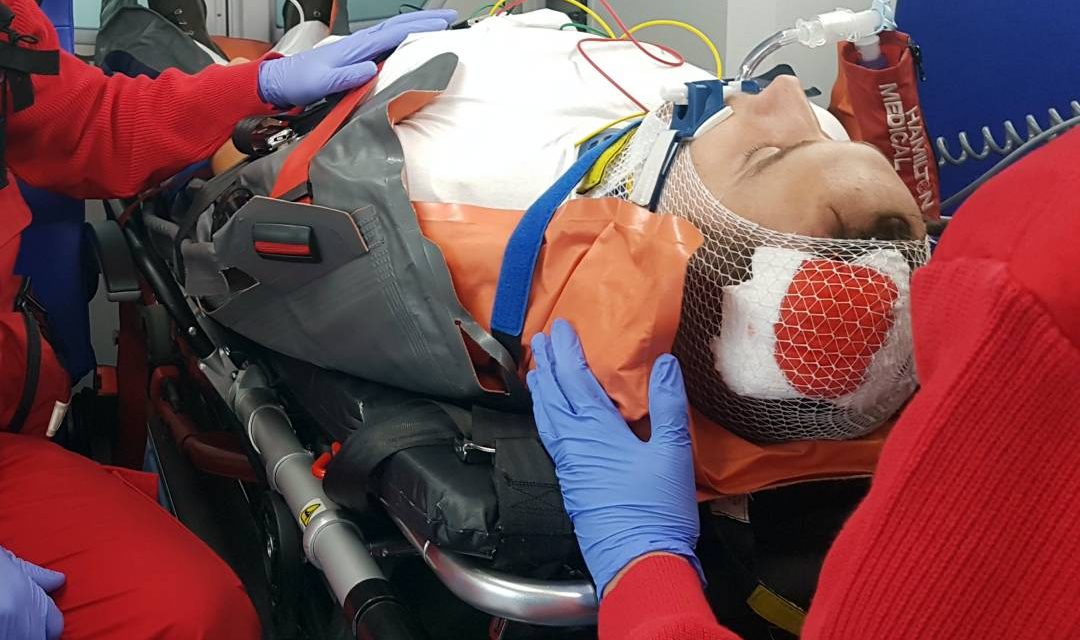After securing the airway and stabilizing the endotracheal tube, post-intubation care for the patient begins. This care includes continuous monitoring of vital parameters, administration of drugs to maintain the patient’s level of consciousness and neuromuscular blockade, and mechanical ventilation.
During the procedure and transportation to the health facility, the patient remains under constant supervision, and appropriate procedures are carried out as necessary. Continuous patient monitoring includes assessment of their level of consciousness, breathing, ECG monitoring, pulse, NIBP (non-invasive blood pressure measurement), SpO2 (arterial blood oxygen saturation) and EtCO2 (endotracheal carbon dioxide content).
During transport and in order to maintain the patient’s level of consciousness and neuromuscular blockade, sedatives and longer-acting relaxants are applied as needed, which have been prepared beforehand.
After successful intubation, the patient is connected to a mechanical ventilator and ventilated according to the parameters set by the doctor.
Since the patient is sedated and relaxed and there is no attempt at spontaneous breathing, controlled mandatory ventilation is used. In mechanical ventilation controlled mandatory ventilation (VC CMV), a set volume of inspired air is delivered to the patient at a set frequency. Inhalation ends when the delivered volume (stroke volume) of air and oxygen (6-8 ml/kg patient body weight) is delivered.
This mode of ventilation includes mechanisms to prevent lung injury caused by mechanical ventilation. Excessive delivered volume can lead to volutrauma, while excessive pressure can cause barotrauma.
In pressure ventilation, inhalation is determined by the pressure and duration of inhalation. The mixture of gases is delivered to the lungs under constant pressure. The flow is not always the same; it is higher at the beginning and gradually decreases based on the filling of gases in the lungs, increased resistance in the airways and lung elasticity.
When transporting a patient to a healthcare facility, it is necessary to coordinate with the emergency service, stating the expected time of arrival, and to provide the necessary equipment and human resources so that the patient can immediately receive the expected medical care.
After intubation, patient care is critical to maintain a safe and effective airway and protect respiratory function. Here are some key steps in post-intubation patient care:
- Confirmation of tube position: First, it is necessary to confirm that the endotracheal tube is correctly placed in the trachea. This can be done by auscultating the lungs to ensure that air is heard in the lungs and not in the stomach. A capnograph/capnometer may also be used to measure exhaled carbon dioxide to confirm proper placement of the tube in the trachea.
- Fixation of the tube: The endotracheal tube should be securely fixed to prevent its displacement from the trachea. Use special straps or fixation devices to ensure stability.
- Ventilator Connection: Connect the endotracheal tube to a ventilator or mechanical ventilation device. Set ventilation parameters according to the patient’s needs, including respiratory rate, stroke volume and pressure.
- Vital signs monitoring: Continuously monitor the patient’s vital signs, including oxygen saturation (SpO2), blood pressure, pulse and capnography. These data will help to assess the effectiveness of ventilation and the general condition of the patient.
- Maintenance of anesthesia or sedation: Most intubated patients will be under anesthesia or sedation to prevent discomfort and reflexes. Medications are constantly adjusted to maintain an adequate level of anesthesia or sedation.
- Prevention of complications: One should be aware of possible complications after intubation, such as pneumothorax, aspiration, vocal fold injuries and others. Take measures to prevent them.
- Prevention of aspiration of gastric contents: Special attention should be paid to the prevention of aspiration of gastric contents into the respiratory tract. This is especially important in patients at increased risk of regurgitation or gastroesophageal reflux.
- Communication: If possible, communicate with the patient or their family to provide information and support.
- Continuous assessment and care: Continue to monitor the patient and ensure their well-being. Patients’ needs change, so it is important that care is constantly adapted.
Post-intubation care requires teamwork and careful attention to detail to ensure the patient’s safety and well-being during the intubation period.



0 Comments